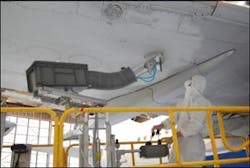Making sanding fast, efficient, and stress-free for human operators
Sanding and polishing are major elements of aircraft maintenance, and — over time — a source of repetitive stress injuries for workers using handheld tools. However, robotic sanders can be too expensive for small and medium shops to deploy!
What to do? Temple Allen Industries in Rockville, MD, has invented a human-controlled robotic sander/polisher called EMMA. Short for easily manipulated mechanical arm, “EMMA is a 100 percent pneumatically-powered device that holds single or multiple sanders, grinders, buffing tools, or blasting nozzles, and that allows sanding (with or without vacuum) to be performed faster, better, and more safely,” says John Wentz, Temple Allen general manager. “Functionally, it is a cable-driven manipulator powered by pneumatic cylinders operated by joysticks. The ‘arm’ portion attaches to the actuation box (holding the cylinders) and wields one of many sanding, grinding, polishing, or blasting end effectors.”
In the aerospace industry, EMMAs are fitted with 3M Scotch-Brite, sandpaper, or blasting media surface preparation materials for use on bare metal, bare composite, pin hole filler, bondo, primer, release agent, surfacer, or topcoats.
“The whole EMMA can be mounted on fixed rails — on a stacker platform or scissor lift — on a ‘creeper’ style low cart for overhead sanding under the belly or wings, on or on a rolling stand that can reach up under wings or work along the sides of the fuselage,” says Wentz. “As a result, there is no part of an aircraft EMMA can’t address. EMMA can also save time resurfacing the tooling used to form composite parts, so it is not limited to the planes themselves.”
Being a human-controlled robot, EMMA costs less than a computer-controlled robotic system that requires programming to deal with different situations. EMMA is also safe to work around, unlike a robotic work area that must be divided off from human work zones to prevent injuries.
Most importantly, EMMA is efficient, typically speeding up manual sanding operations by a factor of 4 to 7 times. This allows work to be executed more quickly, moving planes through the shop faster and thus reducing labor costs.
Speaking of labor, EMMA is popular with workers because it doesn’t replace them. In fact, “EMMA makes each worker much more productive while reducing the health risks (repetitive stress injuries and ergonomic damage from vibration, unnatural postures, and high grip forces) that workers are subjected to now,” says Wentz. “EMMA empowers aircraft technicians by making them more valuable to themselves, their companies, and their families; in that they can now go home and play with their kids without pain in their arms and shoulders from holding a sander all day.
“Management is thrilled that production rates go up and that healthcare costs go down, while workers are happy they aren’t in pain anymore. Increased per-worker productivity means that each operator’s job is that much more secure, and we haven’t had any complaints about that, either.”
To date, EMMA is being used on civilian and military aircraft made by a variety of manufacturers — from commercial wide-body planes and business jets to combat aircraft and helicopters.
“EMMA is a particularly good solution for composite surfaces, and is the only alternative to manual sanding we know of approved for use on the new composite fuselage designs,” says Wentz.
Information about EMMA can be found online at www.templeallen.com.
